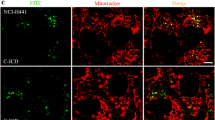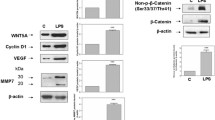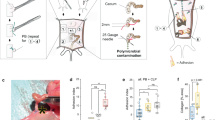Abstract
Background
Although systemic responses to carbon dioxide (CO2) pneumoperitoneum have been studied, there have been few reports of local responses within the peritoneum. We investigated the expression of mRNA for adhesion molecules involved in cell-cell interactions, including ICAM-1, VCAM-1, CD44, E-cadherin, P-cadherin, and N-cadherin, afte the induction of a CO2 pneumoperitoneum in mice
Methods
Mice were treated with CO2 pneumoperitoneum (4–6 mmHg for 30 min) and then killed after 24 h, 48 h, and 72 h. The peritoneum of the abdominal wall was resected, and total RNA was extracted by the acid guanidinium thiocyanate-phenol-chloroform extraction procedure, cDNA were synthesized by reverse transcription. Expression of the mRNA for each gene was normalized to that of β-actin for semi-quantitative reverse transcription-polymerase chain reaction (RT-PCR).
Results
The expression of P-cadherin mRNA was significantly increased at 48 h (p=0.007) and returned to the control level by 72 h after CO2 pneumoperitoneum. The expression of CD44 increased gradually, reaching a peak at 48 h and returning to the control value by 72 h after CO2 pneumoperitoneum. Expression of ICAM-1 mRNA was not changed significantly after the application of CO2.
Conclusion
The expression of P-cadherin mRNA in the peritoneum can be induced to repair injuries to mesothelial cells caused by CO2 pneumoperitoneum.
Similar content being viewed by others
References
Adachi Y, Shiraishi N, Shiromizu A, Bandoh T, Aramaki M, Kitano S (2000) Laparoscopy-assisted Billroth I gastrectomy compared with conventional open gastrectomy. Arch Surg 135: 806–810
Chomczynski P, Sacchi N (1987) Single-step method of RNA isolation by acid guanidinium thiocyanate-phenol-chloroform extraction. Anal Biochem 162: 156–159
Johnson P, Maiti A, Brown KL, Li R (2000) A role for the cell adhesion molecule CD44 and sulfation in leukocyte-endothelial cell adhesion during an inflammatory response? Biochem Pharmacol 59: 455–465
Jonjic N, Peri G, Bernasconi S, Sciacca FL, Colotta F, Pelicci P, Lanfrancone L, Mantovani A (1992) Expression of adhesion molecules and chemotactic cytokines in cultured human mesothelial cells. J Exp Med 176: 1165–1174
Kitano S, Shimoda K, Miyahara M, Shiraishi N, Bandoh T, Yoshida T, Shuto K, Kobayashi M (1995) Laparoscopic approaches in the management of patients with early gastric carcinomas. Surg Laparosc Endosc 5: 359–362
Mathew G, Watson DI, Rofe AM, Baigrie CF, Ellis T, Jamieson GG (1996) Wound metastases following laparoscopic and open surgery for abdominal cancer in a rat model. Br J Surg 83: 1087–1090
Nakayama H, Yokoi H, Fujita J (1992) Quantification of mRNA by non-radioactive RT-PCR and CCD imaging system. Nucl Acids Res 20: 4939
Naot D, Sionov RV, Ish Shalom D (1997) CD44: structure, function, and association with the malignant process. Adv Cancer Res 71: 241–319
Neuhaus SJ, Texler M, Hewett PJ, Watson DJ (1998) Port-site metastases following laparoscopic surgery, Br J Surg 85: 735–741
Nose A, Takeichi M (1986) A novel cadherin cell adhesion molecule: its expression patterns associated with implantation and organogenesis of mouse embryos. J Cell Biol 103: 2649–2658
Poulin EC, Mamazza J, Schlachta CM, Grégoire R, Roy N (1999) Laparoscopic resection does not adversely affect early survival curves in patients undergoing surgery for colorectal adenocarcinoma. Ann Surg 229: 487–492
Shiraishi N, Adachi Y, Kitano S, Bandoh T, Katsuta T, Morimoto A (1999) Indication for and outcome of laparoscopy-assisted Billroth I gastrectomy. Br J Surg 86: 541–544
Shimoyama Y, Hirohashi S, Hirano S, Noguchi M, Shimosato Y, Takeichi M, Abe O (1989) Cadherin cell-adhesion molecules in human epithelial tissues and carcinomas. Cancer Res 49: 2128–2133
Shimoyama Y, Nagafuchi A, Fujita S, Gotoh M, Takeichi M, Tsukita S, Hirohashi S (1992) Cadherin dysfunction in a human cancer cell line: possible involvement of loss of α-catenin expression in reduced cell-cell adhesiveness. Cancer Res 52: 5770–5774
Sidhu GS, Thaloor D, Singh AK, Raghunath PN, Maheshwari RK (1996) Enhanced biosynthesis of extracellular matrix proteins and TGF-beta 1 by polyinosinic-polycytidylic acid during cutaneous wound healing in vivo J Cell Physiol 169: 108–114
Stocchi L, Nelson H (2000) Wound recurrences following laparoscopic-assisted colectomy for cancer. Arch Surg 135: 948–958
Suematsu T, Shiromizu A, Yamaguchi K, Shiraishi N, Adachi Y, Kitano S (1999) Convenient murine pneumoperitoneal model for the study of laparoscopic cancer surgery. Surg Laparosc Endosc 9: 279–281
Vittimberga FJ Jr, Foley DP, Meyers WC, Callery MP (1998) Laparoscopic surgery and the systemic immune response Ann Surg 227: 326–334
Volz J, Köster S, Leweling H, Melchert F (1997) Surgical trauma and metabolic changes induced by surgical laparoscopy versus laparotomy. Gynecol Endosc 6: 1–6
Volz J, Köster S, Spacek Z, Paweletz N (1999) Characteristic alterations of the peritoneum after carbon dioxide pneumoperitoneum. Surg Endosc 13: 611–614
Volz J, Köster S, Spacek Z, Paweletz N (1999) The influence of pneumoperitoneum used in laparoscopic surgery on an intraabdominal tumor growth. Cancer 86: 770–774
Yamaguchi K, Hirabayashi Y, Shiromizu A, Shiraishi N, Adachi Y, Kitano S (2000) Enhancement of port-site metastasis by hyaluronic acid under CO2 pneumoperitoneum in a murine model. Surg Endosc (in press)
Yamaguchi K, Hirabayashi Y, Suematsu T, Shiraishi N, Adachi Y, Kitano S (2001) Hyaluronic acid secretion during CO2 pneumoperitoneum and its association with port-site metastasis in a murine model. Surg Endosc 15: 59–62
Author information
Authors and Affiliations
Additional information
Online publication: 12 June 2001
Rights and permissions
About this article
Cite this article
Tahara, K., Fujii, K., Yamaguchi, K. et al. Increased expression of P-cadherin mRNA in the mouse peritoneum after carbon dioxide insufflation. Surg Endosc 15, 946–949 (2001). https://doi.org/10.1007/s004640090114
Received:
Accepted:
Issue Date:
DOI: https://doi.org/10.1007/s004640090114




